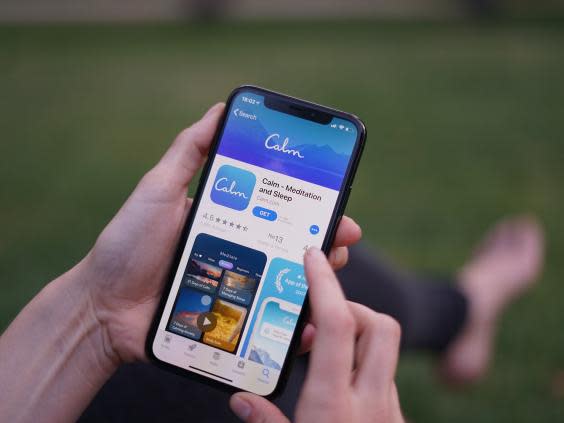‘It’s hard to maintain a soft, whispering voice’: The instructor behind Calm on how words can soothe our minds
Last year, during a stretch of anxious nights, I stumbled upon an app that offered to help me fall into a deep and restful sleep. It would do this by, essentially, programming my phone to lull me into unconsciousness. Now, every night, I crawl into bed and scroll aimlessly through my phone in the dark until I have exhausted all of its mindless distractions – email, Instagram, a virtual wooden-block puzzle. Then I open one last app. My phone speaks to me for 20 minutes, and then it plays nature songs for a very long time.
The voice in the phone is a woman’s, which I like. I don’t need some man telling me what to do. Her tone is gentle and optimistic. It sounds like she is smiling as she speaks. Her words are crisp and clear, but they are softened, almost slurred around the edges, as if she is delicately easing me into each sentence and then releasing me back into silence. Her “ands” are so subdued that they are nearly implied. Sometimes she pauses for long stretches at a time, and that is wonderful, too.
The voice tells me to do things – to breathe in deeply, and breathe out slowly – but I have listened to the exact same recording so many times now that it barely registers as instruction. It’s more like she’s administering some kind of sound tranquilliser. The app is a “sleep and meditation” service called Calm, and it costs £34.99 a year. It’s been downloaded more than 52 million times.
For several weeks, I tapped into Calm at night without thinking much about what I was doing. The whole point of the recording was for me to focus on the voice – not on the meta implications of enlisting my smartphone to spark a parasocial relationship with a stranger whom I now require to fulfill a core human need. But soon I began to wonder who was whispering into my brain every night. Ours is a strangely intimate relationship. Hers is the last voice that I hear before I go to sleep. She speaks to me past the point that I am even aware that I am hearing anything.
One night, as I prepared to start the recording, I noticed her name. Narrator: Tamara Levitt. Author: Tamara Levitt. As I explored the app further, I discovered that she had written and recorded hundreds of meditations. Her voice can guide a person through depression, loneliness, eating and commuting. There are sessions specifically designed to speak into your ear as you’re walking down the street.
I googled her and clicked through photos of her smiling easily on a rocky beach, her hair tousled in the wind. I read the awed user comments that unspooled beneath Calm’s YouTube page and percolated across social media. Fans call Levitt’s voice “marvellous,” “hypnotic” and “somehow magic”. One user said that her voice “has helped heal my brain”. If Levitt recorded commercial voice-overs, another wrote, “I’d probably end up buying three insurance policies and a Snuggie before snapping out of it.”
A couple of months ago, I wrote to Levitt and told her I wanted to learn more about how she spoke so intimately to millions of people at once. Then I flew to Toronto to hear her in person.
Internet culture is often described as hyper-visual, but it has also cracked open new relationships to sound. The rise of podcasts – designed to be listened to alone, in interstitial moments – has forged new aural pathways and carved out its own aesthetic category: the “podcast voice,” that wry, stammering, cool-nerd cadence. YouTube’s ASMR, or autonomous sensory meridian response, practitioners work their whispers and breaths and mouth noises to evoke physical sensations. Even the sounds of jogging geese and crackling ice are preserved for their #oddlysatisfying effects.
Mindfulness apps are exploring how voices could tinker with the inner workings of our minds. In addition to Calm, there are also Headspace, iMindfulness, Aura, Breethe and Buddhify, each with its own central voice. Headspace features a British ordained Buddhist monk with a degree in circus arts; Breethe is built around a recovering “type-A businesswoman”; Buddhify’s meditations are recorded in one of 14 voices. If a user dislikes the voice of a particular track, Buddhify counsels her to “use that difficulty as a focus for your meditation”. No thank you: I am permanently pair-bonded to Levitt’s voice.
It is ironic that apps are using the smartphone to help allay problems that are often delivered through the phone itself – distraction, obsession, anxiety, stress. Calm helps redirect my worst phone habits towards more constructive uses; most of its sessions begin with the instruction to close my eyes. But it’s also extended my reliance on my phone deep into the night – even into my unconsciousness.

The evening I fly up to Toronto, my flight is delayed as we wait for thunderstorms to pass over New York. I’m an anxious flyer, so as we sit on the tarmac, I put on Levitt’s recording “Calming Flight Anxiety”. (“Since our fears are rooted in the future, we can return to a place of calm by reconnecting with the present moment.”) The next morning, I walk across downtown Toronto toward Levitt’s recording studio, the Orange Lounge. I tap into Calm again. I’m an anxious interviewer, so I listen to her “Mindful Walking” track and reroute my attention towards my movement. (“Your heel lifts,” she tells me. “The sole of your foot peels off the ground. Then the ball of your foot raises, and your toes follow.”)
When I arrive, I find Levitt bathed in jewel tones: the studio is covered in red and gold tapestries, purple fringed pillows, an orange swirled shag rug, multiple lava lamps. Levitt has a big smile and wonderful posture. She looks like her photographs, but her voice is not quite familiar. It sounds faster and harsher than it does on the app, although it is not at all fast and not at all harsh. It is professional and projected, a little sardonic and pretty Canadian. Her accent is barely perceptible in the app.
Levitt has been recognised in person, by her voice, only twice. She sounds different because she is conversing in another realm. She is not here to soothe me and tuck me in; she is speaking to me as if I am an adult. What sounds relaxing on the app might sound a little woo-woo, even infantilising, in the open air. But the sudden emotional distance between us feels oddly destabilising. Levitt was a musician and a voice-over actress before she became a mindfulness instructor, and it, too, is an art. “It’s much more difficult to do voice work like this than it is to speak normally,” she says. “It’s really hard to maintain a very soft, kind-of-whispery voice.”
When Levitt records, she stands in an expansive room in the studio, at the centre of two screens covered in packing blankets and angled in a slim V-shape, her mouth 4in from the microphone. She has arranged the room so that her audio engineer, Spencer Sunshine, cannot see her from his editing bay. She wants to feel still and unselfconscious. She wants to drift into a partial meditative state.
Visible from the booth is a paisley-printed easel fitted with an iPad (for her script) and an iPod (for keeping time), and a footstool crowded with beverages: a bottle of water, a large white teapot steeped with Breathe Easy tea and a can of Dole apple juice, which helps to quiet mouth smacks. Occasionally Levitt’s hand will emerge from behind the screen, remove a glass and retract. But mostly she is a voice behind a curtain, an extremely chill Wizard of Oz.

Today, Levitt is rerecording the opening line of a new sleep meditation, which is called “Gently Back to Sleep”. The Calm founders rarely comment on Levitt’s content, but one of them, digital entrepreneur Michael Acton Smith, has requested that she soften the first line. It is, “Hi, this is Tamara.” Levitt’s voice has undergone a kind of pleasant erosion in the 4 1/2 years she’s been recording for Calm, every remaining edge sanded down. Recently I noticed that the session I listen to every night had been swapped with a new, silkier recording. Levitt used to present her meditations “more announcer-like”, she says. Now she’s “a little bit more relaxed”. She’s more intimate.
Levitt disappears behind the screen. Sunshine puts on some spacey music. Levitt tries the line – “Hi, This is Tamara” – and her Calm voice crackles pleasantly in the editing bay. Then she coughs and slices back in with her real voice: “See, it becomes sexy if it’s too soft. Let me try it again.”
It’s really hard to maintain a very soft, kind-of-whispery voice
Tamara Levitt, narrator and author of the Calm app
After recording the line five or six times, Spencer plays the clips back to her, instantly stitching each option into the full recording, and Levitt chooses the one she likes best. She not only writes and records the meditations but oversees the editing, too. Later she will deliver precise instructions for how long each pause ought to be between each line – eight seconds, or 16, or one minute, 50 seconds. As I listen to her, dictating the editing of the meditation from behind the screen, it strikes me that she is among the most valuable content creators on Earth. Imagine if much of Netflix content was conceived, written, performed and edited by the same person.
For all the talk of the podcast revolution, its forms are basically recognisable. Vox’s The Weeds is a youthful, progressive spin on panels like The McLaughlin Group. The Joe Rogan Experience draws from the sprawling programmes of AM radio, one part Imus in the Morning, one part Coast to Coast AM. And comedy podcasts are a rollicking extension of late-night talk shows.
But mindfulness apps represent something that feels totally remote. Listening to them can seem, at first, like padding around a science-fiction film, absorbing ambient noises while forging companionship with a kind of audio gynoid. In addition to Levitt’s meditation recordings, Calm offers a whole range of relaxation-adjacent audio experiences: audio tracks adapted from Bob Ross’s The Joy of Painting, recordings by ASMR YouTubers, the sounds of distant owls and strong winds recorded in the wilds of Northern California, and bedtime stories for grown-ups narrated by people like Matthew McConaughey, who is a natural. “Let your mind drift with me for just a minute,” McConaughey begins. “Let’s ask the question: how often do we ponder the depth of the present moment?”
There is a choose-your-own-relaxation feeling to Calm. Most meditation content is evergreen, so the app can invest in customisation, drawing the listener into the process. A user can choose her session’s theme, length (options range from about a minute to about an hour) and signature nature sound. “I’m the guy who picks ‘Rain on Leaves’,” LeBron James, a Calm evangelist, has said. I’m partial to “Forest Ambiance”.

In a world ruled by content, Calm offers a kind of anti-content. Half of the programming is stuff designed to fall asleep to: if it’s working, you don’t hear it. I gladly pay to listen to the exact same thing night after night. Although the mindfulness meditation sessions can take on a kind of narrative structure, they work to dispel the stories we tell ourselves. They encourage us to dispassionately observe our emotions, to deconstruct our physical surroundings into colours and textures and sounds, to fixate on the air entering our nostrils as we breathe. I treasure some of Levitt’s lines like dialogue in a movie I’ve seen a thousand times. My favorite is: “Become aware of the mattress or floor beneath you, offering support.” It makes me feel as if my Beautyrest is my friend.
Maybe that sounds nuts. It’s true that the meta-conversation around these apps can be oddly stressful. Embedded in them is a strange confluence of nonjudgmental acceptance and the pursuit of peak performance of that nonjudgmental acceptance. Calm calls itself “the Nike of the mind” and rewards users with a meditation “streak” every time they complete a session. Buddhify has a series where you meditate on various features of your smartphone’s interface – “Now, resting your eyes on the big round pause button in the middle ...” – that is too absurd to complete. Even the word “Buddhify” freaks me out. For some students of Buddhism, and critics of capitalism, these applications represent a perversion of a social good in the service of a cult of the self. They call it “McMindfulness.”
If you’re looking for an app to be your Buddha, Calm will disappoint you. But I am not religious, and I am also not spiritual-but-not-religious. I am a person who downloaded a game to my phone that advertises itself in the app store as “Addictive best block puzzle”, and I need help.
We are often said to be living in an “attention economy”, where advertisers and content creators and technologies are competing to gobble up the scarce resource of human attention. Most of the media pumped out by Netflix or Hulu or Luminary or countless mobile game developers is bent on grabbing that attention and not letting it go. Calm wants your attention, too, but it wants you to pay attention to thinking about attention – and the ways you waste it on self-hatred, and stress, and the endless scroll of social media. Much of internet culture works by fitting a second skin over our experience, feeding us roiling commentaries and meta-narratives and boundless information. Calm strips away all the layers of meaning until all that’s left is the sensation of your toes lifting off the ground.
After the recording session, I meet up with Levitt for dinner at Toronto’s SoHo House, where she is a member. It’s loud. We are almost shouting across the table. I ask her how it feels to have a one-sided intimate relationship with millions of people. She tells me that it is unreal. It’s overwhelming, and it’s a huge responsibility. She is accessing such depths of emotion with such a vast group of people. In supporting so many beginners, the smallest sounds can make a difference. Even the pauses must be timed strategically. If she leaves people in silence for too long, they may feel unsupported. They’ll wonder, “Where did she go?”
As we talk, I begin to worry that I am learning too much about her – that she took her first intensive meditation course in treatment for an eating disorder, that she has used it to help deal with her relationship with her father, that she still deals with anxiety, that she does not believe she has reached enlightenment, that for two years she regularly worked 12-hour days on Calm. I worry that this knowledge might distract me from my pure relationship with her voice. But when I put on the recording late that night in my hotel room, her story falls away, and I fall asleep.
© New York Times

 Yahoo News
Yahoo News 